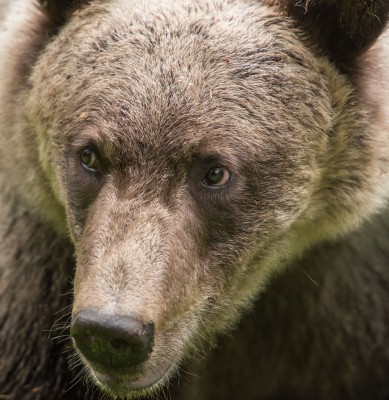
I love bears. I’ve spent a lot of time with them over the years in Alaska, observing most of them in Southeast Alaska. But never have I had an up-close experience like the one that happened last August. With a group of about ten other photographers, I was at a place called Anan Creek, site of the largest pink salmon run in Alaska. Each year about a million of these fish funnel up a waterfall during the final throes of their lives, laying eggs in the calmer waters above the falls before dying. Naturally this attracts all kinds of animal gourmands, from ravens and eagles on up to the mightiest predators of the forest: bears. Both black and brown (a coastal form of the grizzly) bears crowd the falls, and antics and fishing styles vary. All of this is visible from a beautifully designed viewing platform and blind.
As we neared the platform on our mile-long hike through the rainforest, we rounded a corner and in the lush green grass close to an outhouse (which is outside the fenced platform) sprawled a mama brown bear and her two second-year cubs. We stopped, and bunched closely together, as bears can count and have never been known to attack a large group of people. The sow slapped the outhouse door around a bit, then sprawled across the steps leading to the platform. Soon, she and the cubs moved to a soft bit of turf beneath a tree and fell sound asleep, twitching and dreaming much like a family dog, for over an hour. They were 20 feet away.
Finally, the family awoke, cubs yawning. One of the cubs was curious about us and approached as close as five feet before we shouted and waved our arms. All three bears then slowly sauntered off into the brush. Throughout this encounter, I felt a sense of trust from the bears.
When I tell my Alaska bear stories, listeners always ask, weren’t you frightened? Yes and no. Humans have a primal fear of these huge, immensely powerful animals. Yes, bears have killed people. Bears are not pets and can turn violent at any time. However, they are also intelligent, curious creatures. Mutual respect is a good thing. At Anan Creek, bears are partially habituated to humans. They also have plenty of fish to eat and are not likely to regard humans as something to eat.
Contrast this with other places. In most of Alaska bears are hunted. When I have encountered bears in these hunting areas, the bears typically run away. Even worse, bears see humans as having food, either from garbage dumps or from snacks inadvertently left in cars. Yosemite, with its highly sophisticated bears, is a good example of this. Only a few days before our Anan encounter, I had been in Denali, and last year a photographer approached to within 50 feet of a bear, who felt crowded enough that it turned on the photographer, killing him. Now rangers and bus drivers admonish visitors to approach no closer than 300 feet. Contrast this with a mom and her cub only a few feet away at Anan. I feel incredibly blessed. Here is a photo of one of the cubs, from a distance of about eight feet. The slight greenish cast is from the grass just below the animal.
